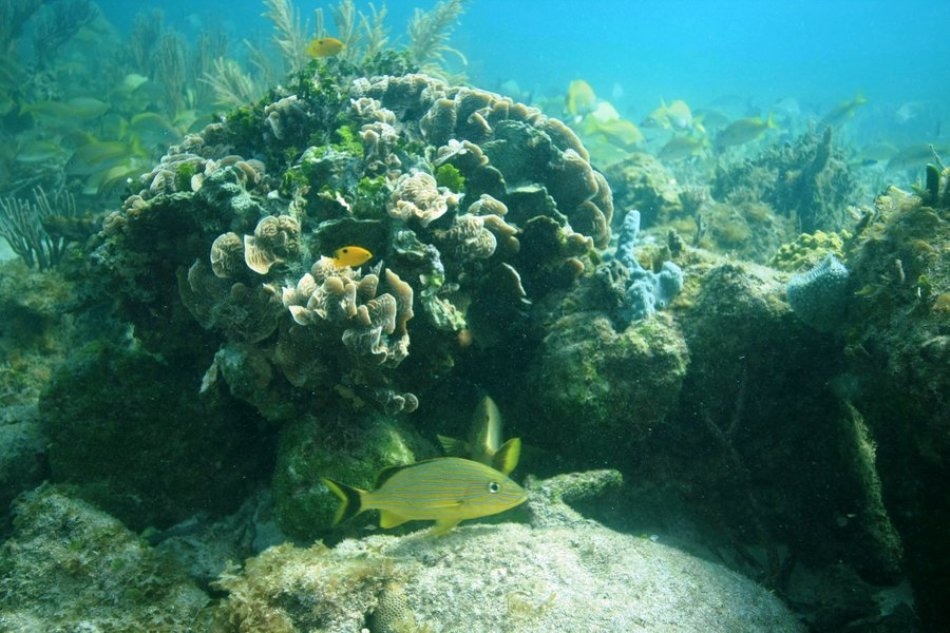Aug 12 2019
For millions of years, corals have been the principal framework builders of reef structures forming habitats for the different community of species. It is well established that ocean acidification, which is being intensified with increasing climate change, is affecting coral growth more and more.
 Coral reefs off the coast of the Mexican peninsula Yucatan near groundwater sources (Ojos). (Image credit: Elizabeth D. Crook)
Coral reefs off the coast of the Mexican peninsula Yucatan near groundwater sources (Ojos). (Image credit: Elizabeth D. Crook)
Researchers from the GEOMAR Helmholtz Centre for Ocean Research Kiel and the University of California have now found solutions to some questions on whether and how corals can become accustomed to these variations by gaining significant understanding about the regulatory processes of coral calcification.
The study outcomes have been reported in the international journal Nature Communications on August 8th, 2019.
Corals—small polyps that derive calcium carbonate from seawater and employ it to construct their elaborate skeletons—equally attract amateurs as well as experts. However, climate change, with increasing water temperatures and intensifying ocean acidification, is altering the living conditions of corals at an unparalleled rate.
Whether they can get on with these changes and become accustomed is an open question. Currently, scientists from the GEOMAR Helmholtz Centre for Ocean Research Kiel and the University of California are offering new understanding with a study reported in the international journal Nature Communications.
The research was co-financed by the Austrian Science Fund FWF (Fonds zur Förderung der wissenschaftlichen Forschung) and the US NSF and involved the study of the response of the stony corals Porites astreoides to high dissolved carbon content and low pH in their natural environment.
Over the millions of years of their evolution, corals have undergone and endured significant environmental variations. Just like tree rings, their skeletons are an environmental record that enables scientists to understand the past.
Conclusions can be made about past environmental conditions from the tiniest differences in the chemical composition of coral skeletons. However, several details related to the manipulation and regulation of skeletal formation processes of corals still remain mysterious.
To gain more insights into these processes, the scientists employed a natural laboratory off the east coast of Mexico. There, groundwater percolates from the virtually circular holes in the seabed, also called ojos. The water has already dissolved calcium carbonate from the Yucatan peninsula rocks and also high carbon dioxide from soil respiration.
When compared to normal seawater, it is more acidic but consists of more dissolved carbon, and therefore, it is similar to the seawater of the distant future. Even with these adverse conditions, the hard-coral Porites astreoides has managed to settle at these ojos. However, the corals in those areas grow more gradually than similar species that grow outside the ojos.
Unlike corals that are exposed to such an acidic environment in laboratory experiments for only a few weeks to months, the corals we sampled live under such conditions for their whole life history.
Prof. Dr Adina Paytan, Study Co-Author, University of California Santa Cruz
For the research, samples were obtained from corals thriving at different distances from the ojos. Therefore, the scientists were able to examine corals of the same species with differing degrees of change in seawater composition.
From the previous study, it is understood that the ratio of boron and carbon isotopes in coral skeletons offers information about the chemical properties of the calcifying fluid during skeleton formation.
Kiel is one of the few locations where we have the necessary analytics to be able to measure these parameters simultaneously and with high resolution. We are thus able to measure two important parameters of coral calcification.
Dr Jan Fietzke, Study Co-Author, Physicist, GEOMAR
The studies revealed a nearly constant chemical composition of all samples.
From this, we can conclude that each polyp creates a calcifying fluid that is largely independent of the seawater conditions surrounding it yet even small changes in the two parameters studied can have an effect on calcification.
Dr Marlene Wall, Study First Author, GEOMAR Marine Biologist
Model calculations on coral growth using these chemical data looked like the decrease in growth measured in the field emphasizing their significance to aid growth. The corals in an environment with a lower pH at the ojos should work harder to increase their pH to the observed level. This process possibly utilizes more energy.
As the corals should allocate their energy reserves over several vital functions like food acquisition, digestion, defense against diseases, or reproduction, they grow more gradually. However, other factors like the calcium concentration in the calcifying fluid or the role of coral symbionts provide the possibility for further study.
“The study has also shown that we still have a long way to go before we understand all the interactions between changes in seawater and coral growth,” summarizes Dr Wall.